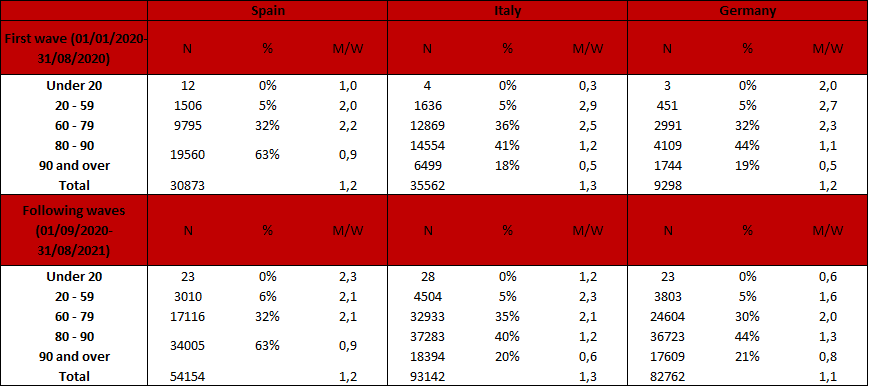5. Taking account of deaths according to sex and age
Given the vulnerability to the virus of the elderly, national population age structures play a decisive role in the number of deaths. Table 7.1 shows deaths by age and sex for three countries, Spain, Germany, and Italy, for the period until 1 September 2020 (the first wave) and the period from 1 September 2020 to 1 September 2021 (following waves). For Spain, the data covers the number of deaths for people aged 80 and over, with no differentiation of deaths from 80 to 90 or those of individuals aged 90 and over.
In both periods, the elderly accounted for the largest part of COVID-19 deaths. Through 1 September 2020, 95% of all COVID-19 deaths concerned people aged 60 or over in Spain, Germany, and Italy, with 60% concerning individuals aged 80 and over. Under 60s accounted for around 5% of total deaths in the three countries. COVID-19 deaths were extremely low for individuals aged under 20.
In all three countries, more men than women died from COVID-19. In the first wave, the differential, all ages combined, was 22% in Spain, 35% in Italy and 24% in Germany. The difference was lower among the extremely elderly, as the proportion of women in these age groups is higher. The higher rate of male deaths declined during the following waves in Italy and Germany but not in Spain, the differential falling to 28% in Italy and just 10% in Germany.
Table 7.1. Numbers, percentages and sex ratio (male/female) of deaths by COVID-19 published by sex and age in 3 countries
With data from "The Demography of COVID-19 Deaths (2021). (INED): https://dc-covid.site.ined.fr/en/ »

